In software development, ensuring application quality remains a critical priority. As applications grow more complex, manual testing becomes increasingly time-consuming and inefficient. Test automation frameworks address this challenge by streamlining the testing process and accelerating feedback cycles.
This blog post dives into test automation frameworks, particularly those designed for the popular programming languages .NET and Java. We'll compare the most popular frameworks, analyzing their strengths, weaknesses, and ideal use cases to help you select the best option for your project.
The Rise of Test Automation Frameworks
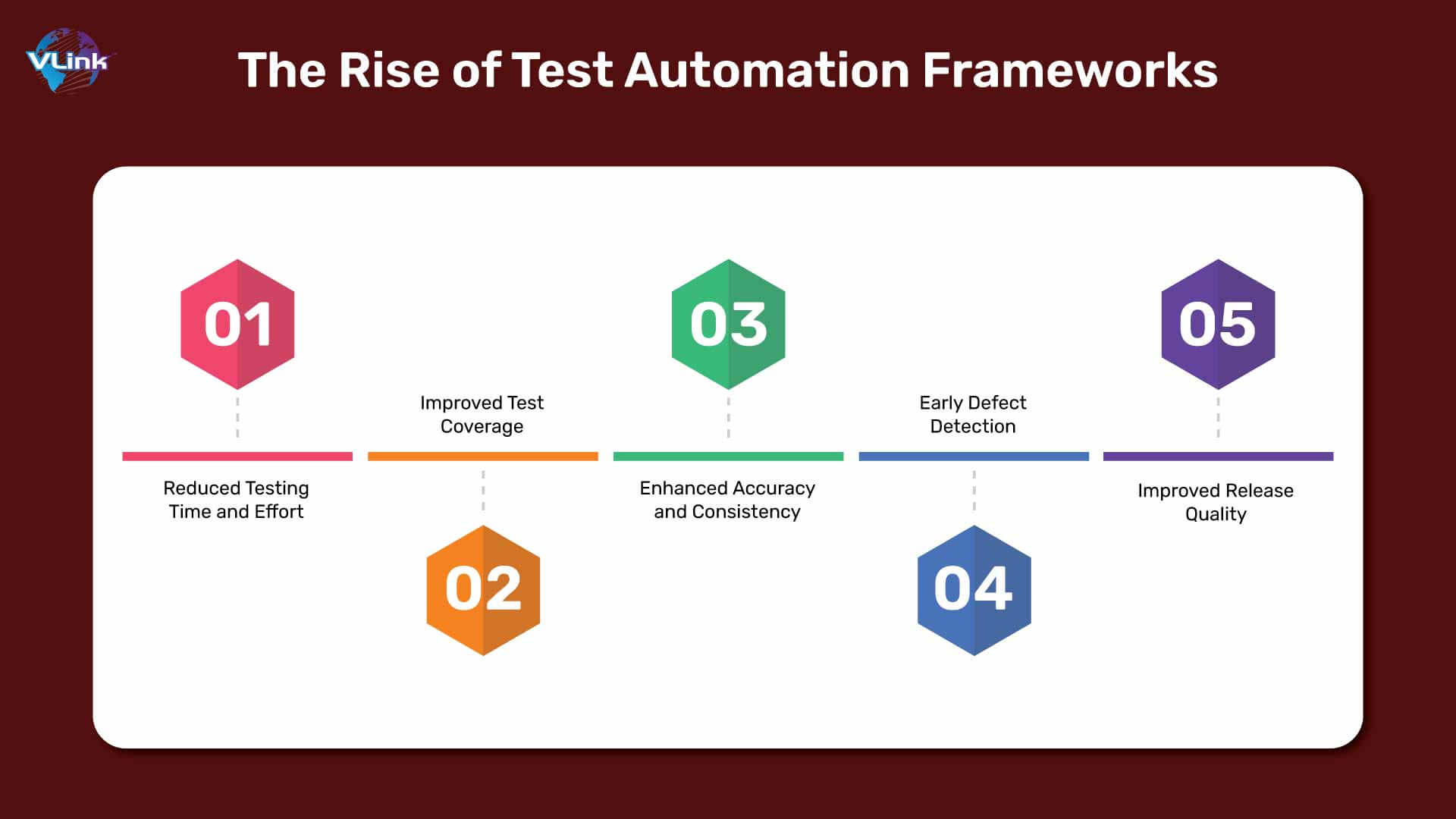 The need for robust test automation is undeniable. According to a World Quality Report, 70% of organizations leverage test automation frameworks. This widespread adoption is attributed to several factors:
The need for robust test automation is undeniable. According to a World Quality Report, 70% of organizations leverage test automation frameworks. This widespread adoption is attributed to several factors:
- Reduced Testing Time and Effort: Automation eliminates repetitive manual tasks, freeing up valuable developer resources for other critical activities.
- Improved Test Coverage: Automation enables comprehensive testing, covering a wider range of scenarios than manual testing.
- Enhanced Accuracy and Consistency: Automated tests are less prone to human error, ensuring consistent and reliable testing results.
- Early Defect Detection: Automation allows for faster regression testing, leading to earlier detection and rectification of bugs.
- Improved Release Quality: Organizations can deliver higher-quality software with greater confidence by automating a significant portion of the testing process.
We've established the significance of test automation frameworks. Now, let's dive into a detailed comparison of popular options for .NET and Java development.
Popular Test Automation Frameworks for .NET
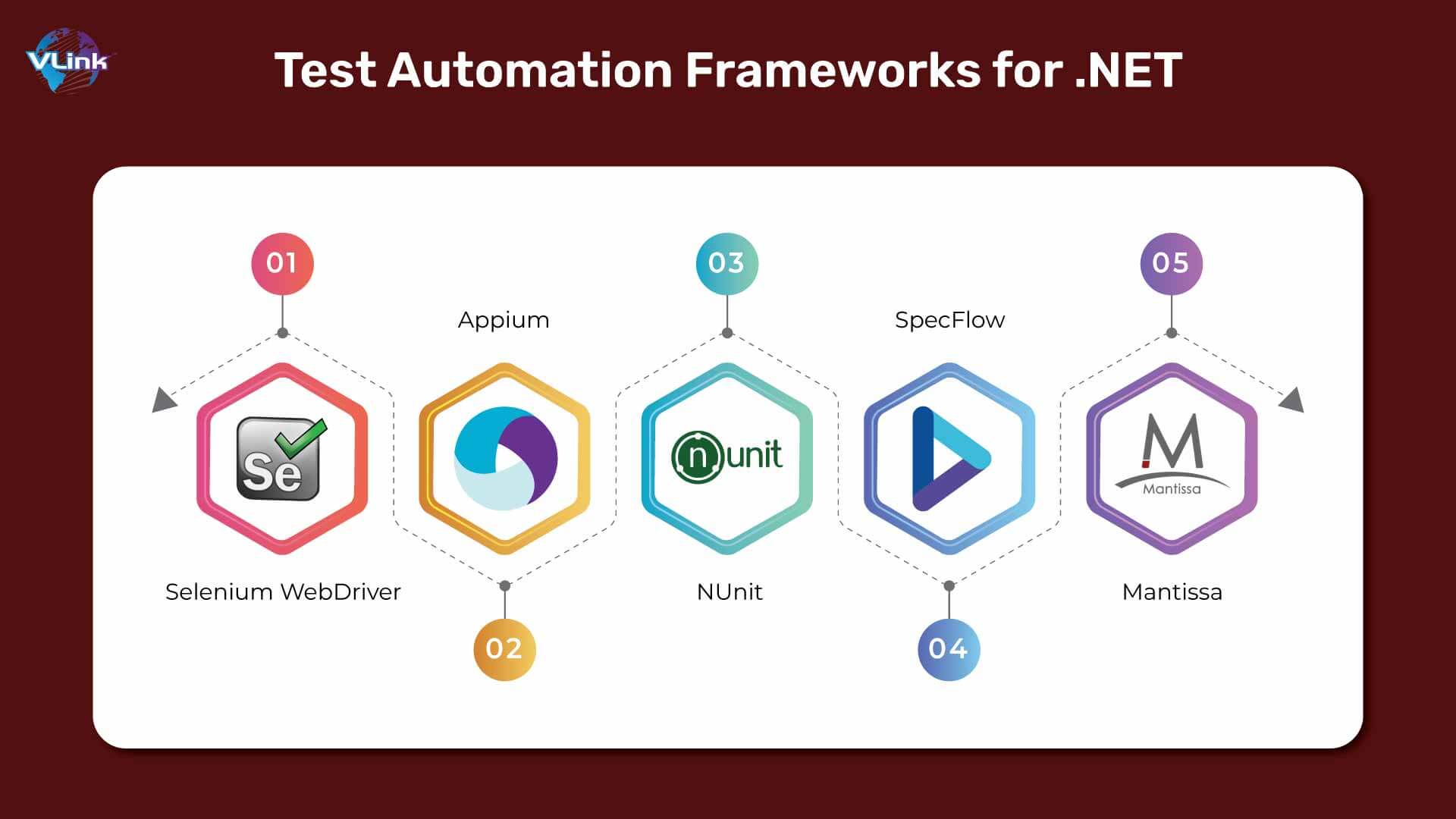 Selenium WebDriver:
Selenium WebDriver:
Selenium is an open-source browser automation framework that supports various programming languages, including C#. It excels at web UI testing, enabling interaction with web elements like buttons, text fields, and links.
Pros:
- Cross-browser compatibility: Supports testing across different browsers.
- Open-source and free to use.
- Large community and extensive documentation
Cons:
- Requires coding knowledge (usually in C# for .NET projects).
- It can be complex to set up and maintain for large test suites.
Appium:
Appium is an open-source mobile test automation framework derived from the Selenium project. It facilitates testing across native, mobile web, and hybrid mobile applications.
Pros:
- Supports testing on various mobile platforms (iOS, Android, etc.).
- Open-source and free to use.
- Integrates well with Selenium for web UI automation.
Cons:
- Requires knowledge of mobile development concepts and frameworks.
- Setting up and maintaining test scripts can be time-consuming.
NUnit:
NUnit is a free, open-source unit testing framework for .NET. It offers various features for writing and executing unit tests, including assertions, test fixtures, and test runners.
Pros:
- Simple to learn and use.
- Supports various testing frameworks like Selenium and Appium.
- Offers features like test discovery and categorization.
Cons:
- Primarily focused on unit testing; not ideal for complex UI automation.
- Additional tools may be required for reporting and advanced test execution.
SpecFlow:
SpecFlow is an open-source BDD (Behavior-Driven Development) testing framework for .NET. It allows test scenarios to be written in a readable Gherkin language, promoting better collaboration between testers and developers.
Pros:
- Improves communication and collaboration within teams.
- Supports integration with various testing frameworks (.NET, Java).
- Enhances test readability and maintainability.
Cons:
- Requires additional tools for test execution and reporting.
- It might have a steeper learning curve compared to simpler frameworks.
Mantissa:
Mantissa is a free, open-source test automation framework for .NET applications. It offers a record-and-playback approach for UI testing, simplifying test creation for web applications.
Pros:
- Easy to learn and use, especially for testers with limited coding experience.
- Record-and-playback functionality reduces scripting effort.
- It supports data-driven testing and integrates external data sources.
Cons:
- Limited to web UI automation; not suitable for unit or API testing.
- It may not be ideal for complex test scenarios requiring extensive customization.
Choosing the most suitable .NET test automation framework hinges on your project's requirements. Consider factors like application complexity, testing types needed (UI, API, etc.), and team expertise. You can make an informed decision by carefully evaluating these aspects and reviewing the strengths and weaknesses of each framework explored here.
If you seek expert assistance in implementing or leveraging these frameworks within your .NET development project, consider hiring skilled .NET developers. They can streamline your testing process, ensure comprehensive coverage, and deliver high-quality software.
While the previous section explored popular .NET frameworks, it's important to acknowledge the dominance of Java in the test automation landscape. Let's now delve into some well-regarded Java-based frameworks.
Popular Test Automation Frameworks for Java
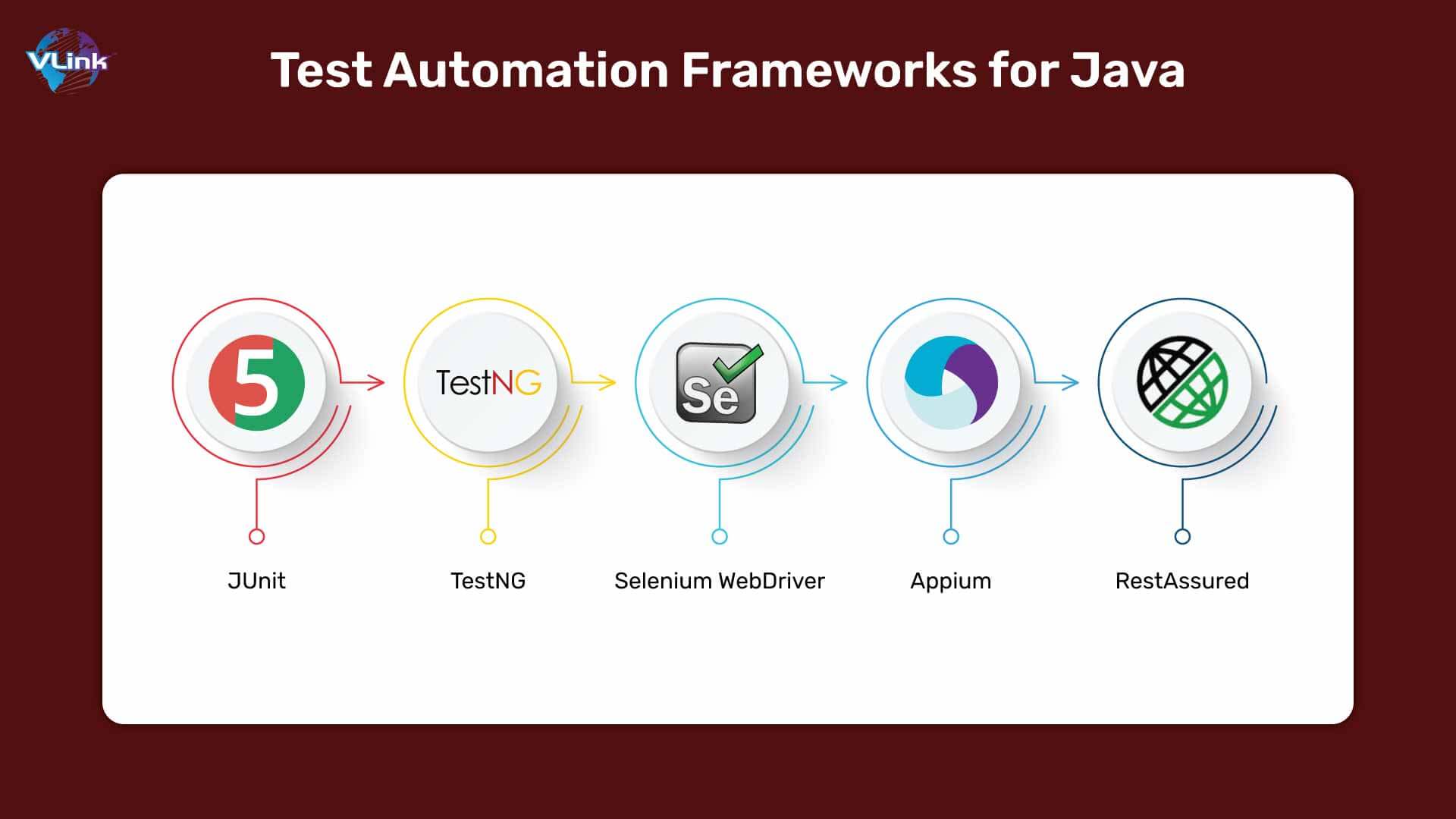
JUnit:
JUnit is the de facto standard unit testing framework for Java. It provides a robust foundation for writing and executing unit tests, offering features like test runners, assertions, and test fixtures.
Pros:
- Widely adopted and well-supported by various IDEs and build tools.
- Simple to learn and use, with a large community and extensive documentation.
- Integrates well with other Java testing frameworks.
Cons:
- Primarily focused on unit testing; not suitable for complex UI or API automation.
- It might require additional tools for reporting and advanced test execution.
TestNG:
TestNG is an open-source, powerful Java testing framework that extends JUnit's functionalities. It offers annotations, data-driven testing, parallel execution, and flexible reporting.
Pros:
- More comprehensive than JUnit, supporting various testing types (unit, functional, API).
- Offers features for test grouping, dependency management, and parallel execution.
- Integrates with various testing tools and reporting frameworks.
Cons:
- Slightly steeper learning curve compared to JUnit.
- Might be considered overkill for simple unit testing scenarios.
Selenium WebDriver (Java-based):
As mentioned earlier, Selenium WebDriver is a language-agnostic framework. Here, we'll focus on its usage with Java. Selenium is an open-source browser automation framework that supports Java. It excels at web UI testing and enables interaction with web elements.
Pros:
- Cross-browser compatibility: Supports testing across different browsers.
- Open-source and free to use.
- Large community and extensive documentation
Cons:
- Requires coding knowledge (usually in Java).
- It can be complex to set up and maintain for large test suites.
Appium (Java-based):
Like Selenium WebDriver, Appium is a mobile test automation framework that can be used with Java. Appium is an open-source mobile test automation framework derived from the Selenium project. It facilitates testing across native, mobile web, and hybrid mobile applications.
Pros:
- Supports testing on various mobile platforms (iOS, Android, etc.).
- Open-source and free to use.
- Integrates well with Selenium for web UI automation.
Cons:
- Requires knowledge of mobile development concepts and frameworks.
- Setting up and maintaining test scripts can be time-consuming.
RestAssured:
RestAssured is a popular open-source Java library that simplifies API testing. It offers a clean and concise syntax for building API requests and validating responses.
Pros:
- Makes API testing easier to write and maintain compared to raw HTTP requests.
- Supports various HTTP methods, assertions, and response validation.
- Integrates well with other Java testing frameworks like TestNG.
Cons:
- Primarily focused on API testing; limited functionality for UI or unit testing.
- It might require additional tools for advanced test management and reporting.
Selecting the most effective test automation framework in Java development hinges on your project's specific needs. The complexity of your application, the types of tests required (unit, API, UI, etc.), and your team's existing skillset all play a crucial role. You can make an informed decision by carefully evaluating these factors alongside the strengths and weaknesses of the frameworks explored here.
If you're seeking to leverage the power of test automation frameworks within your Java project but require expert assistance, consider hiring skilled Java developers. Their experience and knowledge can streamline your testing process, maximize test coverage, and ultimately empower you to deliver high-quality Java applications.
Choosing the Right Framework: A Summary Table
To aid in your decision-making process, here's a table summarizing the key considerations for each framework:
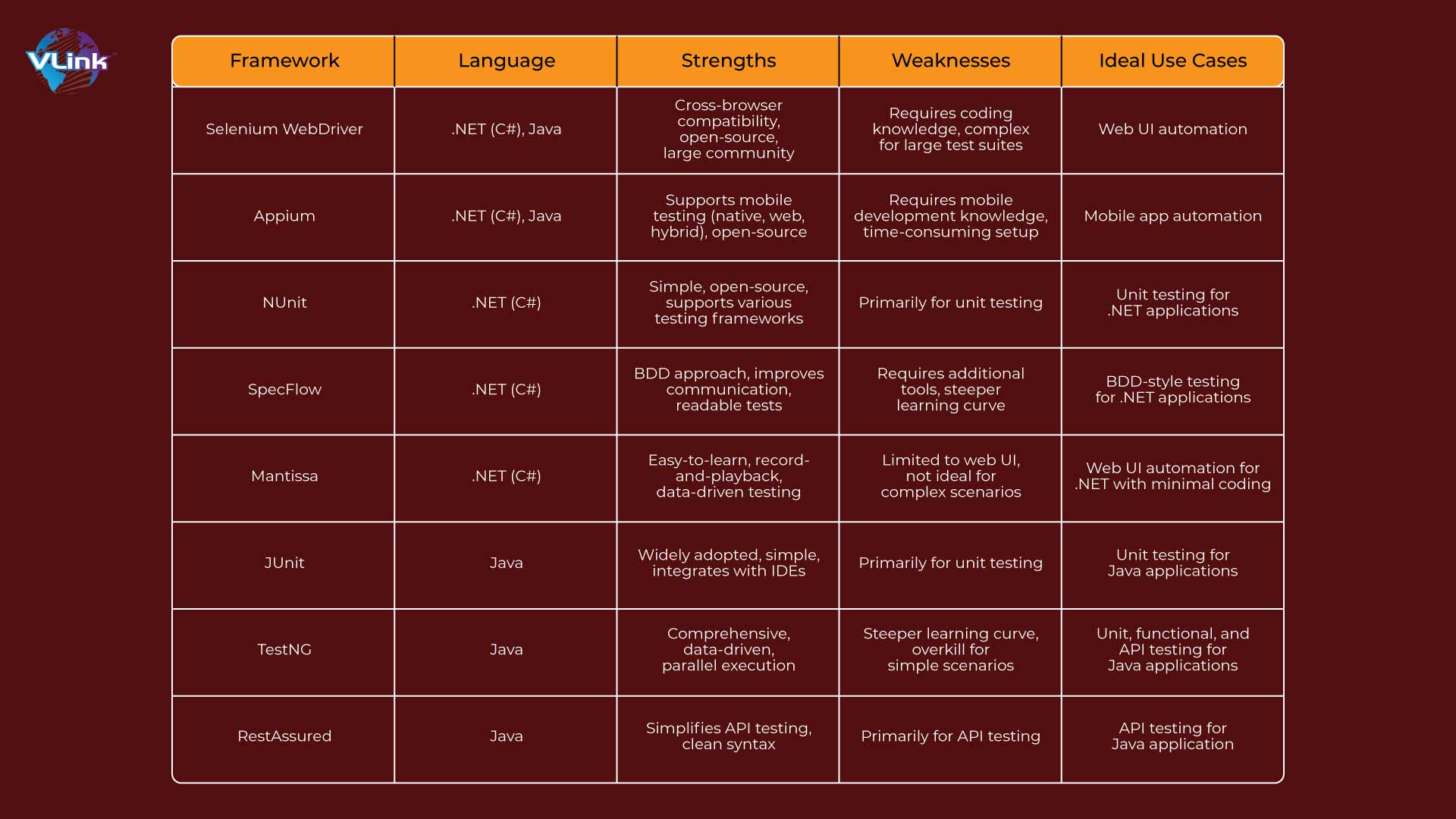
Beyond the Table: Combining Frameworks for Enhanced Testing
The table offered a comprehensive comparison of various test automation frameworks. However, in the real world, software development projects are rarely confined to a single testing type. Often, a robust testing strategy necessitates the strategic integration of multiple frameworks. This approach, known as "combinatorial testing," leverages the unique strengths of each framework to create a more holistic testing experience.
To ensure a well-rounded testing strategy, consider hiring a test automation engineer with expertise in various frameworks for your team. This will allow you to tailor your testing approach to the specific needs of your project and achieve optimal test coverage.
Here's how combining frameworks can empower your testing strategy:
Comprehensive Test Coverage:
Employing frameworks specializing in different testing areas (unit, UI, API) can help you achieve a broader test scope. Imagine combining JUnit for unit testing, TestNG for API testing, and Selenium WebDriver for web UI automation within a Java project. This enables you to test the application's core functionalities, interaction with external APIs, and user interface—all under one roof.
Improved Efficiency:
While some frameworks excel in specific areas, they may need more functionalities in others. Combining frameworks lets you focus on each other's strengths, potentially streamlining the testing process. For instance, you could leverage Selenium WebDriver's record-and-playback feature for initial web UI test creation and then switch to a more robust framework like TestNG for managing complex test scenarios and reporting.
Enhanced Collaboration:
Modern testing methodologies like BDD (Behavior-Driven Development) emphasize communication and collaboration between testers, developers, and stakeholders. Frameworks like SpecFlow, which promotes BDD practices, can seamlessly integrate with other test automation tools. This fosters a shared understanding of test cases and expected outcomes, leading to more efficient collaboration.
The decision to combine frameworks hinges on your specific project requirements. Carefully evaluate your testing needs and identify areas where different frameworks can complement each other. This strategic approach can significantly enhance your testing coverage, improve efficiency, and ultimately contribute to delivering higher-quality software.
How to Choose the Right Test Automation Framework
Selecting the most suitable test automation framework hinges on various project-specific factors. Here are some key considerations:
- Programming Language: The framework should be compatible with the chosen development language (e.g., .NET or Java, in this case).
- Project Requirements: The complexity of the application, the types of tests to be conducted (functional, UI, API, etc.), and integration needs with other tools all influence framework selection.
- Team Expertise: The team's familiarity with a particular framework can significantly impact adoption and efficiency.
- Open-Source vs. Commercial: Open-source frameworks offer greater flexibility and lower costs, while commercial solutions provide better support and additional features.
Benefits of using a Test Automation Framework
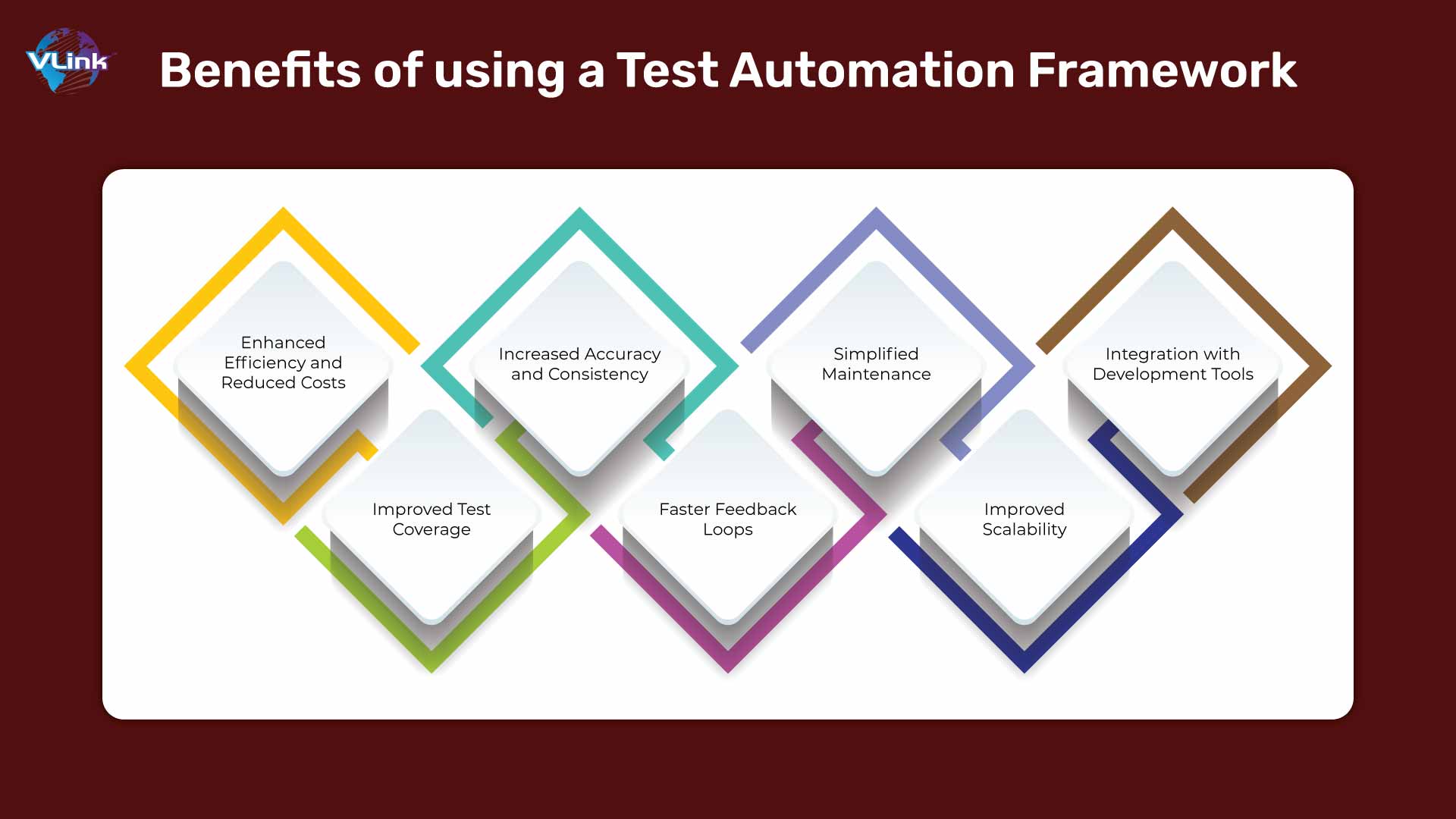 In today's fast-paced development environment, manual testing can be a bottleneck, hindering development speed and potentially introducing errors. Test automation frameworks offer a compelling solution, providing numerous advantages throughout the software development lifecycle:
In today's fast-paced development environment, manual testing can be a bottleneck, hindering development speed and potentially introducing errors. Test automation frameworks offer a compelling solution, providing numerous advantages throughout the software development lifecycle:
- Enhanced Efficiency and Reduced Costs: Automating repetitive tests frees up valuable developer resources for other critical tasks, resulting in faster development cycles and lower project costs.
- Improved Test Coverage: Automation enables executing a broader range of test cases than manual testing. This comprehensive testing approach helps identify and rectify bugs earlier in development.
- Increased Accuracy and Consistency: Automated tests eliminate the possibility of human error, ensuring consistent and reliable testing results. This reduces the risk of regressions (bugs introduced in new code) and promotes higher-quality software releases.
- Faster Feedback Loops: Automation allows for quicker test execution and feedback generation. Developers can identify and address issues promptly, leading to more rapid development cycles and improved time-to-market.
- Simplified Maintenance: Well-designed test automation frameworks promote code reusability, which reduces maintenance efforts. When application code changes, tests need to be updated in fewer places.
- Improved Scalability: Automation empowers running a larger volume of tests consistently. This is particularly beneficial for complex applications or those undergoing frequent updates.
- Integration with Development Tools: Many test automation frameworks integrate seamlessly with popular development tools and continuous integration/continuous delivery (CI/CD) pipelines, fostering a more automated and efficient development workflow.
By leveraging these benefits, test automation frameworks empower development teams to deliver higher-quality software faster and more efficiently.
Future of Test Automation Framework
The landscape of test automation is constantly evolving, with new trends and technologies emerging all the time. Here's a glimpse into what the future holds for test automation frameworks:
- AI and ML-powered Testing: Artificial intelligence (AI) and machine learning (ML) are poised to revolutionize test automation. AI-powered tools can help with tasks like:
- Automatic test case generation: These tools can analyze application behavior and user journeys to automatically generate comprehensive test cases.
- Self-healing tests: AI can identify and adapt to UI changes, keeping your tests resilient and reducing maintenance overhead.
- Predictive analytics: Machine learning algorithms can analyze test results to predict potential defects and prioritize testing efforts.
- Low-code/No-code Automation: Frameworks that require minimal coding or no coding at all will become increasingly popular. This will allow testers and even business analysts to participate in test automation, democratizing the process and improving collaboration.
- Focus on User Experience (UX) Testing: As user experience becomes a critical differentiator, testing frameworks will provide better capabilities for automating UI interaction and usability testing.
- Integration with DevOps and CI/CD Pipelines: Test automation will become even more seamlessly integrated with DevOps methodologies and continuous integration/continuous delivery (CI/CD) pipelines. This will enable faster feedback loops and ensure high-quality software releases.
By staying informed about these trends, you can ensure your team is well-equipped to leverage the future of test automation frameworks and deliver exceptional quality software.
Hire Test Automation Engineer from VLink
In today's fast-paced software development landscape, delivering high-quality applications quickly is paramount. Manual testing, while crucial, can become a bottleneck in the development cycle. Test automation frameworks offer a powerful solution, streamlining the testing process and accelerating feedback loops.
However, implementing these frameworks effectively requires skilled professionals. VLink connects you with talented test automation engineers with the expertise to leverage these frameworks and optimize your testing process.
Our engineers bring a wealth of experience and are proficient in industry-standard frameworks for .NET and Java. They can design, develop, and execute automated test scripts, ensuring comprehensive functional and non-functional testing of your applications. Hiring VLink's test automation engineers are not just technically skilled but also effective communicators who can collaborate seamlessly with developers and other stakeholders. They understand the importance of clear reporting and can provide actionable insights to improve your software's quality.
Partner with VLink and unlock the full potential of test automation frameworks. Focus on innovation while our engineers handle the intricate details of automated testing, ensuring your applications are reliable, robust, and ready for the market.
Key benefits of hiring a Test Automation Engineer from VLink:
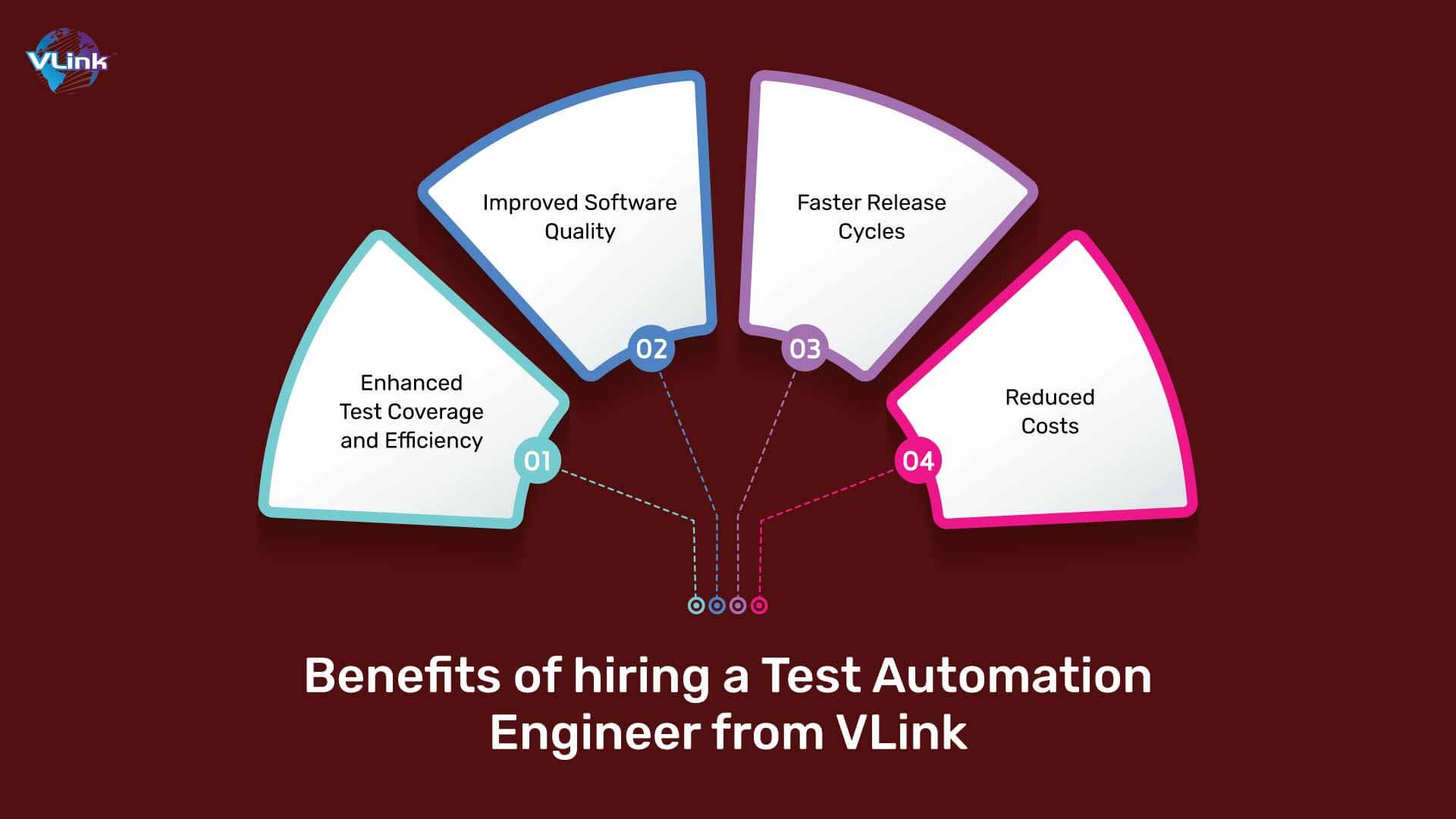
- Enhanced Test Coverage and Efficiency: Our engineers can automate repetitive tasks, freeing your team's time for more strategic testing efforts.
- Improved Software Quality: Automated tests provide consistent and thorough regression testing, reducing the risk of defects slipping through the cracks.
- Faster Release Cycles: By automating tests, you can get quicker feedback on code changes, enabling faster deployments.
- Reduced Costs: Investing in automated testing can save you money in the long run by minimizing manual testing efforts.
Don't let manual testing slow you down. Contact VLink today and build a high-performing test automation team to propel your software development to the next level.
That’s it from our side in this blog. We hope this blog has hopefully equipped you with a comprehensive understanding of popular .NET and Java test automation frameworks. As you embark on your test automation journey, remember to continuously evaluate your needs and explore new tools and frameworks that may emerge.
Conclusion
The landscape of test automation frameworks is vast and ever-evolving. Selecting the most suitable framework hinges on your project requirements, team expertise, and desired functionalities. By understanding the strengths and weaknesses of each framework explored in this blog, you can make an informed decision that empowers you to streamline your testing process and deliver high-quality software.
Remember, the ideal framework might not exist in a vacuum. Consider combining frameworks to leverage their unique strengths. For instance, within a Java project, you could leverage JUnit for unit testing, TestNG for API testing, and Selenium WebDriver for web UI automation. If you have any queries or want to learn more about test automation frameworks and how they can benefit your software development projects, contact us now. We offer various services, including test automation consulting, implementation, and more.
Frequently Asked Questions
Absolutely! Several frameworks mentioned in this blog, including Selenium WebDriver, Appium, NUnit, and RestAssured, are open-source and freely available.
Due to their simpler functionalities, frameworks like NUnit and Mantissa offer a gentler learning curve. However, the "easiest" option depends on your prior experience and project needs.
- Unit testing focuses on individual units of code (functions, classes).
- UI testing verifies the functionality and usability of the application's user interface.
- API testing validates an application's APIs' functionality, performance, and security (Application Programming Interfaces).
- Reduced testing time and effort
- Improved test coverage and accuracy
- Early defect detection
- Enhanced release quality
Absolutely! As discussed earlier, combining frameworks, or combinatorial testing, is a strategic approach to achieving comprehensive test coverage. You can create a more robust testing strategy by leveraging the strengths of different frameworks specialized in various testing areas (unit, UI, API).








